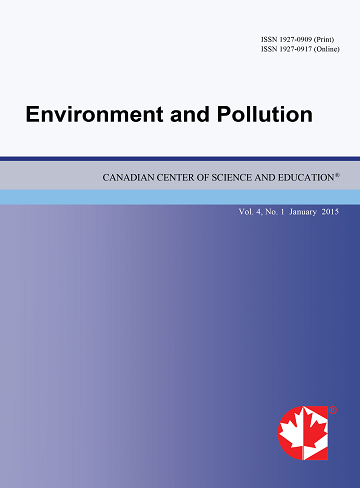Spatial Distribution and Bioavailability of Some Essential Trace Elements in Southern Ondo State Nigeria
- Wasiu B. Tomori
- Isiaka A. Amoo
- Ademola F. Aiyesanmi
- Ernest K. Yanful
- Petrik Leslie
Abstract
The total elemental content of soil though may give abundance of element concentration but have been found not to be suitable for prediction of environmental bioavailability and toxicity by scientific community. Surface (0-30cm) and subsurface (60-90cm) soil profile in the Southern Ondo State Nigeria were investigated for spatial distribution, bioavailability and mobility of some essential trace elements (Cu, Fe, Mn, Zn). Their spatial distribution were very similar in both surface and subsurface soil environment indicating that similar geochemical factors may be responsible for their distribution. The North was composed of basement complex while the South was largely undifferentiated sedimentary rock. Higher concentrations of Cu, Fe, Mn and Zn were recorded in the North through the centre of study area to lower concentrations in the South. The spatial concentration of the trace elements may have been influenced by the nature of underlying bedrock type. Cu was potentially bioavailable in both surface and subsurface soil environment considering the fact that >50% of its total concentration were in the nonresidual fraction. Other trace elements were not bioavailable because >60% of their total concentrations were found in residual fractions. The relative risk assessment code of Cu (surface; subsurface) indicated progressive risk (MoF1, MoF2, MoF3) from low (2-10; 1-6) through medium (12-30; 10-21) to high risk (25-40; 21-35) in both surface and subsurface soil environment while Zn (surface) shows similar trend (1-5; 11-21; 22-35) only in the surface soil environment. Other elements show some level of risk to no risk. There is likelihood that Cu and/or Mn may be associated with anthropogenic sources.- Full Text:
 PDF
PDF
- DOI:10.5539/ep.v4n4p24
Journal Metrics
h-index (2017): 10
i10-index (2017): 11
h5-index (2017): 9
h5-median (2017): 15
Index
- Academic Journals Database
- Berkeley Library
- CAB Abstracts
- CAS (American Chemical Society)
- CNKI Scholar
- COPAC
- CrossRef
- DTU Library
- Elektronische Zeitschriftenbibliothek (EZB)
- EuroPub Database
- Excellence in Research for Australia (ERA)
- Genamics JournalSeek
- Google Scholar
- Harvard Library
- Infotrieve
- Jisc Library Hub Discover
- JournalGuide
- JournalTOCs
- LOCKSS
- Max Planck Institutes
- Mir@bel
- PKP Open Archives Harvester
- Pollution Abstracts
- Publons
- Pubmed journal list
- ROAD
- Scilit
- SHERPA/RoMEO
- Standard Periodical Directory
- Stanford Libraries
- UCR Library
- Ulrich's
- UniCat
- Universe Digital Library
- UoS Library
- WorldCat
- Zeitschriften Daten Bank (ZDB)
Contact
- Albert JohnEditorial Assistant
- ep@ccsenet.org
